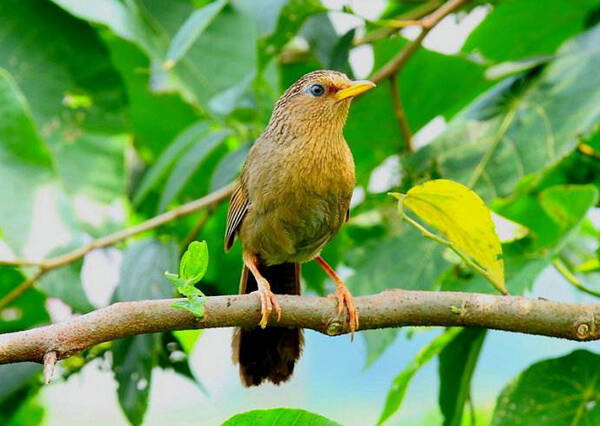Garrulax taewanus
IUCN
LCBasic Information
Scientific classification
- name:Garrulax taewanus
- Scientific Name:Garrulax taewanus,Taiwan Hwamei
- Outline:Songbird
- Family:Passeriformes Thrushidae Laughingthrush
Vital signs
- length:19-25cm
- Weight:54-75g
- lifetime:10-12years
Feature
Very territorial, song similar to that of the mainland thrush
Distribution and Habitat
Native distribution: Taiwan, China.
They generally live in dense grass or shrubs below 300 meters above sea level, and a few can live up to 1,000 meters above sea level.
Appearance
Male and female birds are the same color. The color from the forehead to the back of the neck is tan, and the rachis of each feather is black, connected in a vertical line. The back of the body includes the back, shoulders, waist, wings, flight feathers and tail coverts olive brown, and the outer petals of the primary flight feathers are light brown. The tail feathers are dark brown with more than 10 olive-brown horizontal bands. The gills, throat and upper breast are orange-yellow, the rachis of each feather is dark brown, the lower breast and belly are mouse gray, and the lower belly and undertail coverts are orange-yellow. The beak is yellowish brown and the tarsometatarsus is flesh-colored.
Size measurement: Body weight ♂55~58g, ♀54~75g; body length ♂195~256mm, ♀197~246mm; mouth peak ♂19~23mm, ♀19~23mm; wings ♂86~97mm, ♀83~96mm; tail ♂93~115mm, ♀92~115mm; tarsus ♂33~40mm, ♀33~40mm.
Details
Taiwan Hwamei, no subspecies.

Taiwan Hwamei males are very territorial, and the territory they occupy will not be invaded by males of the same species. If someone who does not know invades, he will be strongly driven away. They are sexually independent, and they gather in small groups in winter. It is often seen jumping between branches or bushes to find food, and never flies long distances.
Taiwan Thrush is omnivorous. It mainly eats various insects and insect eggs, and also eats fruits and seeds of plants.
Taiwan Thrush is good at singing. Not only does it have many syllables, but its singing is loud, melodious and long-lasting, and it can also imitate the singing of other birds. The singing is similar to that of the mainland thrush, but the structure is simpler than that of the mainland thrush.
The breeding season of Taiwan Thrush is from March to August, and it builds its nest in dense Miscanthus or bushes. The nest is bowl-shaped, with different heights from the ground, and is woven by the male and female birds with Miscanthus leaves, thin tree roots and other leaves. The nest is 80mm high, 70mm in diameter and 40mm deep. A nest contains 3 to 5 eggs, which are turquoise blue, spotless and slightly shiny. The egg size is 26.1×20.2mm. The chicks are raised by both parents.
The global population of Taiwan Thrush is about 10,000 (Simba Chan, 2007), and there are about 6,700 adult birds. The number was originally very common (Swinhoe, 1863), and even in the 1950s, there were still many (Hachisuka & Udagawa, 1951), but its habitat area has been greatly reduced due to economic development. At the same time, because of its singing skills, it is a popular pet bird species, and the pressure to capture it has always been great.
The Taiwan Thrush was previously considered a subspecies of the Thrush (Garrulax canorus), and Dickinson (2003) also considered the Taiwan Thrush to be one of the three subspecies of the Thrush. However, the Taiwan Thrush does not have white brow spots and white eye sockets, which is obviously different from other subspecies. Collar (2004, 2006) believes that the Taiwan Thrush should be separated from the Thrush as an independent species. In recent years, molecular biological research has found (Li et al., 2006) that there is a DNA sequence difference of up to 3.5% between the Taiwan Thrush and its mainland subspecies, and it is estimated that the two have diverged about 1.5 million years ago. Therefore, the Taiwan subspecies was separated from the Thrush and promoted to an independent species, namely the Taiwan Thrush (Garrulax taewanus). Collar & Robson (2007) suggested that the species be moved from the genus Garrulax to the genus Leucodioptron.
Listed in the IUCN Red List: Near Threatened (NT), assessed in 2012.
Listed in China's National Key Protected Wild Animal List (February 5, 2021) - Level 2.
Protect wild animals and eliminate game.
Maintaining ecological balance is everyone's responsibility!








